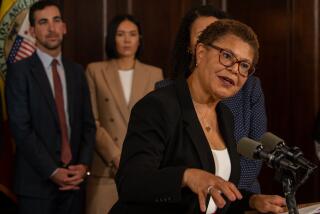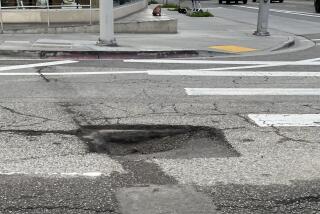Funding for L.A.’s emergency management unit, vital to Palisades recovery, remains static

- Share via
Myriad calamities could hit the city of Los Angeles in coming years: Wildfires. Floods. Mudslides. Drought. And of course, the Big One.
Yet this month, L.A. leaders once again balked at dramatically increasing the budget of the city’s Emergency Management Department, even as the office coordinates recovery from the Palisades fire and is tasked with helping prepare for a variety of disasters and high-profile events, such as the 2028 Summer Olympics.
Facing a nearly $1-billion budget shortfall, the L.A. City Council voted 12 to 3 last week to pass a budget that rejected the funding increases requested by EMD leaders to hire more staffers and fix broken security equipment around its facility.
The only budgetary increase for EMD will come through bureaucratic restructuring. The department will absorb the five-person Climate Emergency Mobilization Office, which Mayor Karen Bass had slated for elimination in her initial proposal to trim the budget deficit.
The funding allotment for EMD — with an operating budget of about $4.5 million — puts the department short of similar big cities in California and beyond.
To supplement the city’s bare-bones emergency management team, Mayor Karen Bass turned to an Illinois-based disaster recovery firm, Hagerty Consulting, inking a yearlong contract for up to $10 million.
As a 2022 audit by then-City Controller Ron Galperin noted, San Diego ($2.46), Long Beach ($2.26) and San Francisco ($7.59) all spent more per capita on emergency management than L.A., which then spent $1.56 per resident. Whereas L.A. has a staff of roughly 30, New York, with more than double the population of L.A., has 200 people in its emergency management team, and Philadelphia, with a population less than half of L.A.’s, has 53.
The current leaders of EMD, General Manager Carol Parks and Assistant General Manager Jim Featherstone, had specifically requested funding this spring to build an in-house recovery team to better equip the city for the Palisades recovery as well as future disasters.
“We are one of the most populous and at-risk jurisdictions in the nation, if not in the world,” Featherstone told the City Council’s budget committee on April 30. “I won’t say negligent, but it’s really not in the city’s best interest to [not] have a recovery capability for a disaster similar to the one we just experienced.”
Zach Seidl, a spokesperson for Bass, pushed back against the idea that EMD’s funding level would hamper the Palisades fire recovery or preparation for the Olympic Games and 2026 World Cup.
“During a difficult budget year, Mayor Bass focused on emergency management to keep Angelenos safe — that absolutely includes ensuring EMD has continued staffing and resources,” Seidl said in a statement. “We will continue to push forward with one of the fastest recovery efforts in state history.”
Councilmember Traci Park — who represents the Palisades — was among the trio on the City Council who opposed the budget that passed last week, citing insufficient funding for public safety as one of her main objections.
Less than 48 hours before the planned reopening, the state said it remains “in the dark” regarding the city of Los Angeles’ plans for providing security to the fire-ravaged Pacific Palisades.
“It’s inevitable that we are going to have another disaster, and we still won’t be prepared. We’ll be in the same position we were before,” said Pete Brown, a spokesperson for Park, who decried cuts to EMD and a lack of resources for the Police and Fire departments.
“We got a horrible taste of what it’s like when we are not prepared,” Brown said, “and despite all of that, we haven’t learned a lesson from it, and we are doing the same thing.”
Rick Caruso, the developer whom Bass defeated in the 2022 mayoral race, called both the budget proposal put forward by Bass and the spending plan approved by the City Council “a blatant display of mismanagement and bad judgment,” expressing incredulity over the rationale for EMD’s funding level.
“We are in an earthquake zone. We are in a fire zone. Come on,” Caruso said in an interview.
Seidl disputed that L.A. had not learned from the Palisades fire and emphasized that the spending on emergency management included “continued and new investments” in EMD as well as the city’s police and fire agencies.
Emergency management experts, audits commissioned by the city and EMD’s current leadership have warned that the department lacked the staff and funding to accomplish its mandate in one of the nation’s most disaster-prone regions.
“That department could be the world leader in emergency management, and it could be the standard for the rest of the country, but with a third of the staff and a tenth of the budget that they need, that’s not possible,” said Nick Lowe, an independent emergency management consultant and the president and chief executive of CPARS Consulting.
The general manager of EMD and an agency spokesperson did not respond to written questions last week about the approved budget.
In recent public statements, Parks disclosed that her budget requests this year received opposition and appeared to have been whittled down.
She told the Ad Hoc Committee for L.A. Recovery in March that she had sought 24 more staffers at EMD, but that officials under the city administrative officer balked at her request.
The Times tested for lead, mercury and other heavy metals in Altadena and Pacific Palisades. From respiratory problems to lung cancer, these are the risks of exposure.
Featherstone, who is now coordinating the Palisades fire recovery, said Parks’ requests received “a qualitative negative response,” and suggested that there was a lack of understanding or appreciation of the import of EMD’s role.
“There was a qualitative opinion not in favor of Ms. Parks having these positions and people who aren’t emergency managers opined about the value or the worth of these positions,” Featherstone said.
Parks said she scaled her request down “given the city’s current fiscal situation,” adding, “I need a minimum of 10” more positions. In a memo, Parks said these 10 positions would cost about $1.1 million per year.
When Bass unveiled her budget proposal, those 10 additional positions were not included; EMD remained at roughly 30 positions, similar to previous years, which cost about $7.5 million when pensions, healthcare and other expenses are included. Bass’ budget proposal touted that she was able to preserve all of EMD’s positions while other departments faced steep staff and funding cuts.
Parks and Featherstone had argued for the creation of a designated, in-house recovery team, which EMD has lacked. When the Palisades fire broke out in January, EMD had no person assigned full time to recovery and instead had to move its limited staff onto a recovery unit. Bass also retained Hagerty Consulting, a private firm, to boost EMD and provide instant expertise on a yearlong contract for up to $10 million, much of which Bass’ spokesperson said is reimbursable by the Federal Emergency Management Agency.
Still, Featherstone has told the City Council that, because L.A. had no in-house recovery expertise, the need to train and create an in-house team has occupied much of the initial Palisades fire recovery effort.
Phasing in an in-house recovery and reconstruction division with 10 staffers would cost an additional $1.5 million next year, according to a memo prepared by the city administrative officer. Hiring an additional 21 staffers to prepare for the Olympics and other major events would cost nearly $3 million.
Parks also requested $209,000 to repair the video system at the emergency operations center, saying the lack of surveillance cameras posed a threat to city employees.
“Multiple incidents have occurred where the safety and security of the facility have been compromised without resolution due to the failing camera system,” Parks wrote in a budget memo submitted this spring.
The request for funding for replacement cameras was also denied.
L.A. officials have long been warned that EMD lacks resources. The 2022 audit by Galperin, the former city controller, found that L.A. provided less emergency management funding than peer cities, and that the COVID-19 pandemic “strained EMD resources and staffing, causing several existing preparedness programs to lag behind, likely impacting the City’s readiness for future emergencies.”
An after-action report on EMD’s handling of COVID-19, written by Lowe, the emergency management consultant, found that the agency was “undervalued and misunderstood, underfunded and demoralized.” Parks took over as general manager after the time period covered by Lowe’s report.
A system to send multilingual alerts during natural disasters was about to be adopted until it was put on hold. Critics of President Trump accuse him of delaying the program because of his disdain for immigrants.
The lack of training and funding became apparent at a budget hearing in April 2024. Councilmember Katy Yaroslavsky asked Parks directly at the meeting, “With your current budget, are you able to staff your [emergency] response centers 24/7 during emergencies?”
“The answer is no,” Parks said. “If there are multiple days that the emergency operations center needs to be activated, we do not have enough staff.”
During the Palisades fire, EMD said, it had to bring in additional emergency management officials from other cities to sustain the emergency operations center around the clock.
Lowe said L.A. leaders had failed to recognize EMD’s role within the broader public safety infrastructure of the city.
“I’m not sure at a political level that the city understands and appreciates emergency management and the purpose of the department, and that trickles down to the budget and the size of the department,” Lowe said.
More to Read
Sign up for Essential California
The most important California stories and recommendations in your inbox every morning.
You may occasionally receive promotional content from the Los Angeles Times.


















